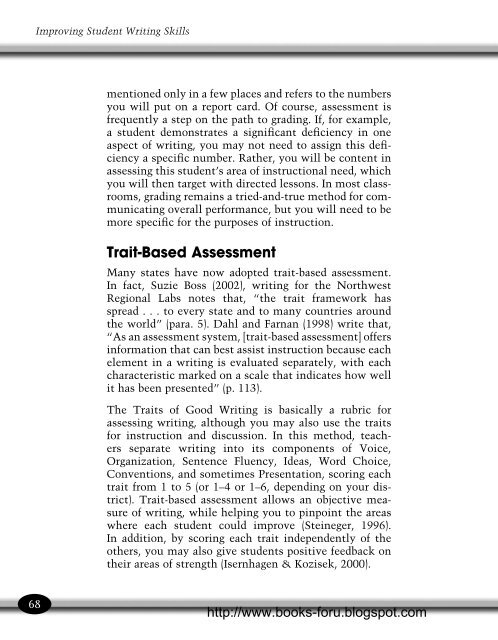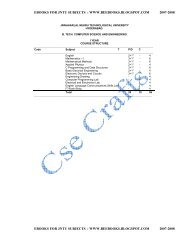Improving Student Writing Skills - cse crafts
Improving Student Writing Skills - cse crafts
Improving Student Writing Skills - cse crafts
You also want an ePaper? Increase the reach of your titles
YUMPU automatically turns print PDFs into web optimized ePapers that Google loves.
<strong>Improving</strong> <strong>Student</strong> <strong>Writing</strong> <strong>Skills</strong><br />
mentioned only in a few places and refers to the numbers<br />
you will put on a report card. Of course, assessment is<br />
frequently a step on the path to grading. If, for example,<br />
a student demonstrates a significant deficiency in one<br />
aspect of writing, you may not need to assign this deficiency<br />
a specific number. Rather, you will be content in<br />
assessing this student’s area of instructional need, which<br />
you will then target with directed lessons. In most classrooms,<br />
grading remains a tried-and-true method for communicating<br />
overall performance, but you will need to be<br />
more specific for the purposes of instruction.<br />
Trait-Based Assessment<br />
Many states have now adopted trait-based assessment.<br />
In fact, Suzie Boss (2002), writing for the Northwest<br />
Regional Labs notes that, “the trait framework has<br />
spread . . . to every state and to many countries around<br />
the world” (para. 5). Dahl and Farnan (1998) write that,<br />
“As an assessment system, [trait-based assessment] offers<br />
information that can best assist instruction because each<br />
element in a writing is evaluated separately, with each<br />
characteristic marked on a scale that indicates how well<br />
it has been presented” (p. 113).<br />
The Traits of Good <strong>Writing</strong> is basically a rubric for<br />
assessing writing, although you may also use the traits<br />
for instruction and discussion. In this method, teachers<br />
separate writing into its components of Voice,<br />
Organization, Sentence Fluency, Ideas, Word Choice,<br />
Conventions, and sometimes Presentation, scoring each<br />
trait from 1 to 5 (or 1–4 or 1–6, depending on your district).<br />
Trait-based assessment allows an objective measure<br />
of writing, while helping you to pinpoint the areas<br />
where each student could improve (Steineger, 1996).<br />
In addition, by scoring each trait independently of the<br />
others, you may also give students positive feedback on<br />
their areas of strength (Isernhagen & Kozisek, 2000).<br />
68<br />
http://www.books-foru.blogspot.com




![JNTU ONLINE EXAMINATIONS [Mid 2 - JAVA] - cse crafts](https://img.yumpu.com/39435151/1/190x245/jntu-online-examinations-mid-2-java-cse-crafts.jpg?quality=85)
![JNTU ONLINE EXAMINATIONS [Mid 2 - ES] - cse crafts](https://img.yumpu.com/15318017/1/190x245/jntu-online-examinations-mid-2-es-cse-crafts.jpg?quality=85)
